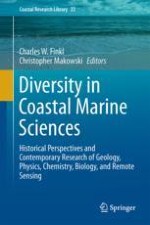Abstract
Across human history, countless scientific works about the sea have been written, and some of them have an eternal nature. The sea, blessed by God since the Genesis (The Bible. “The Old Testament. The Genesis”) (“And God said, “Let the water teem with living creatures, and let birds fly above the earth across the vault of the sky.” So God created the great creatures of the sea and every living thing with which the water teems and that moves about in it, according to their kinds, and every winged bird according to its kind. And God saw that it was good. God blessed them and said, “Be fruitful and increase in number and fill the water in the seas, and let the birds increase on the earth”.” (The Bible. “The Old Testament. The Genesis”, Ch. 1, verse 20–22, p. 2)), has generously offered the most diverse and necessary resources for the existence of humanity. In this respect, since the oldest times, the sea has generated a favorable climate for the development of trade, communication, civilization and great geographical discoveries.
The sea has the great merit of approaching the created man to his Creator. It was one of the main instruments whereby God revealed Himself, showing the power, greatness and beauty of His creation. “The Word of God” was spread by the waters of seas and oceans, to the most remote places of the world. The Savior’s “Gospels” and Teachings were spread by the sea and by the roads crossing the Roman Empire. The first Christian communities and churches were established and fortified in seashore cities, and Christianity was spread by the sacrifice of Christ’s disciples and apostles. The sea also consolidated the spirit of sacrifice and human solidarity. The law of retaliation (eye for eye, tooth for tooth) was replaced by the law professing the Love of God and of our fellow men. Moreover, the endless sea brings us closer to heaven, as it intermingles with the infinite horizon; the sea is a symbol of the union between the terrestrial level and the celestial one, as the sky mirrors itself into the sea.
In one of his works, the writer Giovanni Papini (Papini, G, Viata lui Iisus. Editura Orizonturi, Bucuresti, p 470, 2012) stated that, no matter what, Christ remains the beginning and the end, a beam of divine mysteries at the crossroads of two glimpses of human history. In our paper, we will attempt at presenting several excerpts from the Bible and from other works that describe the role played by the sea in the dissemination of Scriptures and in the evolution of Christianity. Moreover, with God’s help, we also aim at revealing the sea as a “cradle” of miracles, whereby God’s great plans were achieved and He revealed Himself as a “Loving Father” and Creator of the universe. The sea “provided fishers of men” and some of them became Christ’s disciples. At His call, they left their ships and fishing tools and followed Him. This paper will reveal that the sea confirmed the Godhead of the Beloved Son, Jesus Christ. The sea, by its whims, often helped the Apostles, who spread the word of the “Gospel” and worshiped Jesus, who rose from the dead.
We will conclude our paper by an appeal addressed to our readers: the sea is a blessing from God and we will be held responsible to Him with regard to the way in which we respect, use and protect it and its beings. Those who love the sea are not only thinkers whose dreams float on its blue and soothing waters. They are managers and fully responsible to God for the achievement of His creation, including the sea. Watch the stormy sea, float on its furious waves and when restlessness starts to creep into your hearts, you will fully and profoundly understand the words of the wise Solomon, son of David: “The fear of the Lord leads to life, So that one may sleep satisfied, untouched by evil… The fear of man lays a snare, but whoever trusts in the Lord is safe” (The Bible, “The Old Testament. Proverbs of Solomon”).
